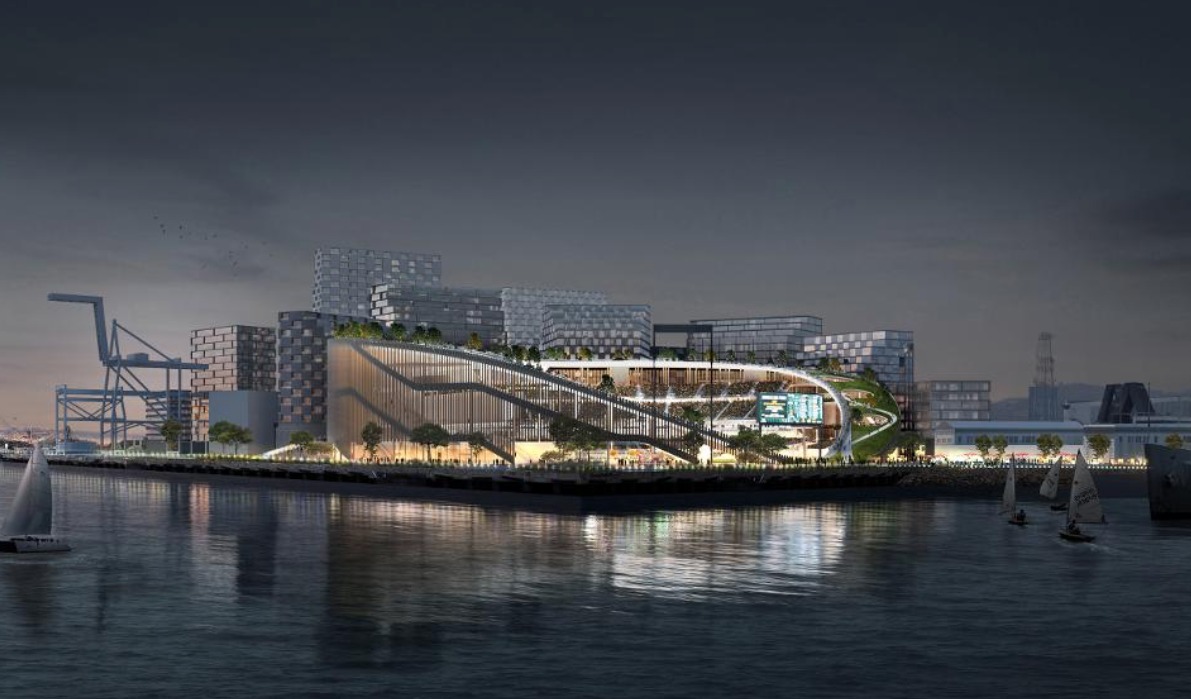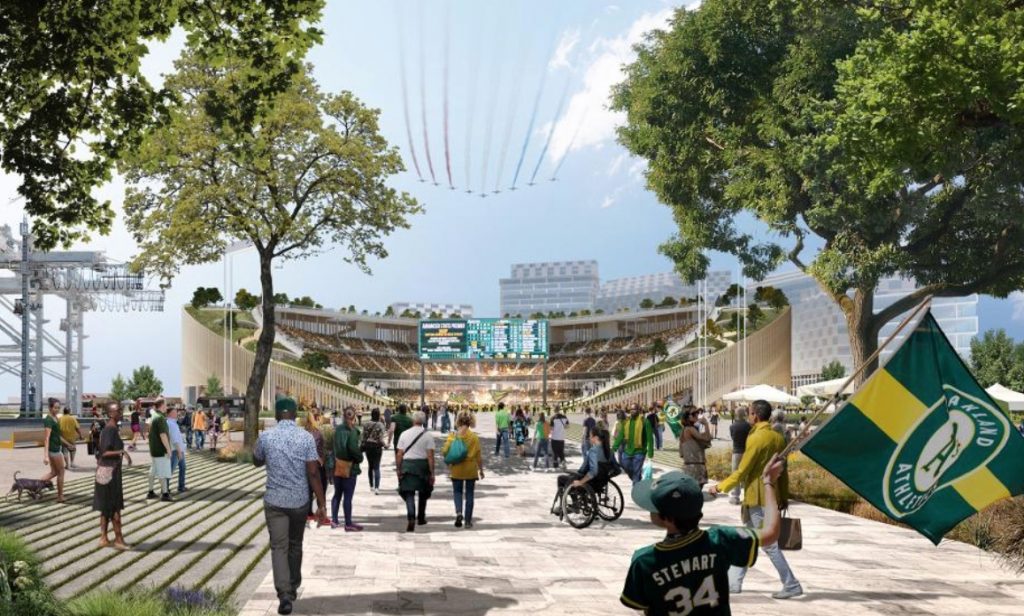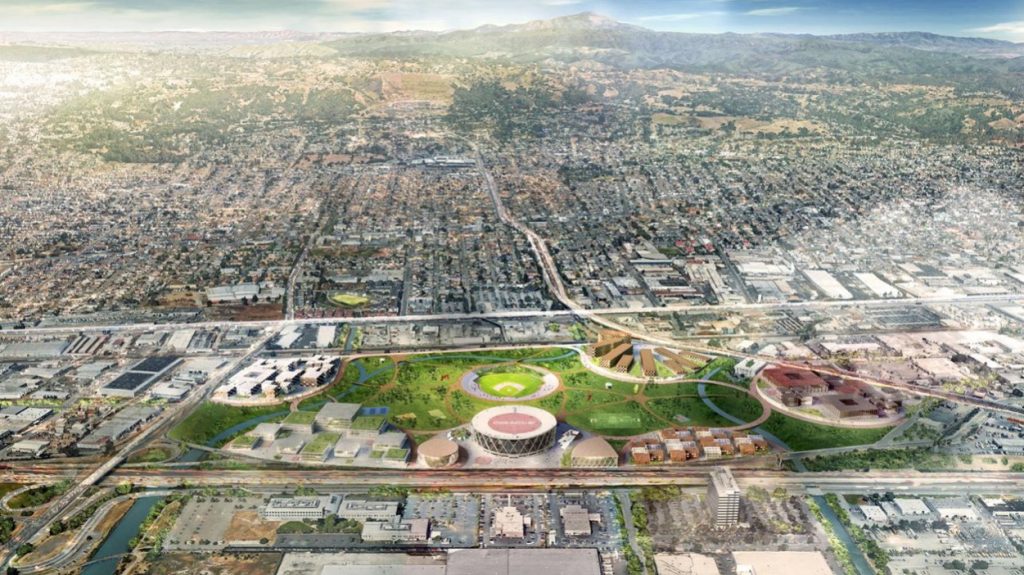- February 25, 2019
- Posted by: SportsV
- Categories: Home News, Industry News, News, Press Releases

Oakland A’s President, Dave Kaval, has been detailing how the team is making progress on the new ballpark district at Howard Terminal ballpark at Jack London Square, including the unveiling of an updated ballpark shape to boost the fan experience.
Dave Kaval, Oakland A’s President, said:
Back in November, we were thrilled and humbled by the initial positive response to our preliminary concepts for the ballpark design. Fans and community members alike expressed excitement about the design. Since then, we’ve continued to meet with public officials, fans, and community members to gather more input and refine our designs.
One key update to our design: a more circular shape. This geometry offers four key benefits over the initial concepts:
- Better ability to capture fan energy inside the ballpark for a more exciting and intimate experience
- A continuous rooftop park for use by fans and the community
- Better views of the water and Oakland from inside the ballpark
- A more seamless, efficient, and fluid access to the ballpark from the surrounding neighborhood
We’ll expect more refinements and improvements as we move through the design process, and your continued feedback will be essential. Please feel free to email me at president@athletics.com.
Environmental justice initiative for West Oakland, I often talk about how the ballpark project is “Bigger than Baseball,” and as we continue to make progress, one of our top priorities is ensuring that the project creates broader economic, environmental, and community benefits for the people of Oakland.

Kaval continued:
After continued conversations with community leaders, we increasingly see that our ballpark project can be an essential catalyst to addressing longstanding environmental issues at the Port and in West Oakland. Our commitments include:
Brownfield transformation
The selection of Howard Terminal provides a unique opportunity for Oakland to transform an environmental “negative” into an environmental “positive.” Currently, the ballpark site is an underutilized urban industrial site (i.e. brownfield) with a history of well-documented environmental challenges, including soil and groundwater contamination. These types of environmental issues are common in large urban infill redevelopment projects, including the sites redeveloped into sports venues such as Oracle Park in San Francisco and SAP Center in San Jose. As part of our pledge to redevelop and privately finance the site, we will fully remediate these environmental issues, at no cost to taxpayers, and redevelop the land into a model of sustainable development, that will include the ballpark, housing (including affordable housing), restaurants, retail, small business space, parks, and open space.
Real Environmental Justice Reform
Our next step is introducing a West Oakland Environmental Justice bill to the state legislature. The bill will expand the scope of issues and benefits that regulatory agencies can consider in evaluating project approvals. This bill ensures that greater emphasis is placed on local environmental justice issues and impacts. The bill is most likely to be opposed by some of the largest polluters in the state, who are responsible for a disproportionate share of the environmental harm done to West Oakland communities, and yet are claiming to object to the ballpark project on environmental grounds. We have also launched an incredible partnership with the West Oakland Environmental Indicators Project (WOEIP), a resident-led community based environmental justice organization to develop a shared environmental justice agenda on issues of public health, air quality, land use and equity.
Green Design
In terms of the ballpark itself, we’re already making great strides toward ambitious environmental goals. We’ve set a high bar for green building, committing to a LEED Gold standard of design, reducing car trips by 20%, achieving net zero emissions, and adding protections to the site in anticipation of future sea level rise caused by climate change.
We are committed to high levels of public engagement, transparency, and accountability, and look forward to sharing more details about our work soon.

The Oakland A’s plan to build a next generation urban ballpark at Howard Terminal adjacent to Jack London Square, as well as to redevelop the Coliseum site. The two-project approach will create significant community benefits for West and East Oakland.
The project’s design team includes Bjarke Ingels Group (BIG), Gensler and James Corner Field Operations.
Images, courtesy: Oakland A’s

